Strategic operations and outsourcing
Executive Summary
Because has given a high priority to innovation, innovation is one of the key elements integrated into its relationship with suppliers. An analysis of P&G’s facility management outsourcing to JLL reveals that the company has effectively identified and realised strategic outsourcing objectives, which is to benefit from external industry knowledge and expertise, to reduce costs through cost savings strategies such as economies of scale and to have enough room for concentrating on its core activities. A further evaluation of the company’s outsourcing activities with JLL reveals that it indulges in a strategic outsourcing choice, which led to the selection of JLL as the sole service provider of facility management services, delivering such services at a global scale. More importantly, this assignment has identified that JLL has 8 out of the 12 core supplier capabilities, confirming that it is an extremely capable service provider, offering business dissertation help.
1.0 Introduction
To achieve their profitability objectives and maintain their competitive advantage, companies have resorted to modern techniques that are efficient, reliable and cost-effective. One of these strategies is the outsourcing of different business functions such as marketing, finance, logistics, supply chain and manufacturing, the latter being extensively involved with outsourcing processes (Kobyletska, 2018). One of top manufacturing companies that has largely been involved in business process outsourcing is the Proctor & Gamble (P&G). The company manufactures and markets a wide range of consumer products including household, beauty and cosmetic products. It is an American multinational headquartered in Cincinnati which sells its products to more than 180 countries globally, with net sales of not less than 84 billion as at 2020 (Suresh et al, 2021). P&G owns at least 145 manufacturing facilities with more than 400 of its products sold to households globally.
From time immemorial, P&G has taken a systems approach to organizational structure development, making it a business unit that supports its business services. An evaluation of its business service reveals three major stages of operation namely: engagement in outsourcing agreements, strategic alliance management and shared service centres. This assignment focuses on P&G’s engagement in outsourcing agreements.

In 2003, P&G decided to enter into an outsourcing arrangement with Jones Lang LaSaille (JLL) to oversee its facility management functions. According to Vitasek & Fenn (2017), this revolutionary deal saw JLL take over the responsibility of overseeing the company’s 14 million square feet of real estate facilities, construction management, facilities development, real estate transaction management, strategic occupancy planning and project development.
An in-depth evaluation of this strategic decision reveals that it was made based on various internal and external factors. With P&G’s global expansion activities in the 90s and the subsequent need to effectively manage services for its internal corporate clients, the company developed a Shared Services Organization that would change the way some of the services were delivered to its business units around the world. According to Choi et al (2021), shared services organization are effective in helping companies to eliminate unnecessary redundancies while enhancing service delivery efficiency. Similarly, according to Vitasek etal (2018), the shared services model facilitates process standardization that creates cost savings – making it possible for companies to support multiple business units while delivering quality services at the required speed. Considering these advantages, shared service organization marked P&G’s journey to business process outsourcing.
By end of 2003, P&G, through its Global Business Services (GBS) conglomerate, had initiated the process of examining the possibilities of outsourcing some of its work. The company realised that while it was achieving advantages from managing its own, a well-managed third party would effectively oversee its facilities management functions to help it derive additional value (Garg & Jain, 2019).
Apart from these internal factors, a significant external factor that drove P&G towards outsourcing for facilities management was to compete more effectively in the dynamically changing goods market. Its competitors such as Unilever were already taking more advantage in the market by outsourcing various business functions including supply chain management, making an awakening call to P&G (Zafar & Kantola, 2018). P&G realised that by outsourcing, they would increase their flexibility and enhance their focus on critical competencies. Similarly, as Ploneczka (2017) observed, outsourcing their facilities management enabled the company to reduce certain costs associated with administrative and back-office functions. Further, P&G outsourced other functions such as employee service management and IT applications and infrastructure. This report critically analyses the outsourcing decision based on the factors influencing the outsourcing decision and its impact on P&G. It also uses theories and concepts of business process outsourcing to evaluate the decision, and finally make recommendations to P&G on how it can improve its operations through business process outsourcing.
2.0 How P&G manages its outsourced facilities management process
In today’s business environment, it is commonly believed that outsourcing creates a variety of operational and strategic benefits. According to Vitasek & Flyin (2018), outsourcing has enabled manufacturers to reduce costs, improve their responsiveness and speed, become more innovative, reduce inventory cycle times, enhance competitiveness, and enhance agility and flexibility. P&G’S decision to outsource its facilities management functions was informed by the need to reduce the resource sand efforts put on non-core activities and increase its attention towards the core activities (Bloomberg 2013), acquire cost advantage through economies of scale while maintaining service quality, and access service provider innovation, facilities and expertise for its own competitive advantage (Pulli, 2018).
After several years of contracting JLL, it is plausible to claim that P&G has achieved a considerable success with its outsourcing strategy. Existing data from Vitasek et al (2012) indicate that JLL has implemented at least 46 successful initiatives, most of them being accepted by P&G as objects of true innovation (ATUT, 2014). Moreover, according to Vitasek et al (2012), JLL has innovatively managed to help P&G reduce its facilities management costs by at least 33%.
The partnership between P&G and JLL has largely been vested’ in nature, offering a facilities management solution that many commentators have claimed to have flipped the conventional outsourcing approach – where the contractor (P&G) contracts for transformation instead of contracting for day to day activities. A classic example is how the partnership has facilitated the delivery of value to the bottom line through effective facilities management. Vitasek & Fenn (2017) observed that through a win-win mentality, the two companies shared the rules of business process outsourcing whereby they both shared the rewards and risks of developing a transformed facilities management (Ike, 2017). Instead of considering ‘What’s In It For Me’ (WIIFMe), both P&G and JLL considered ‘What’s In It For We’ (WIIFWe), forming a foundation of values that helps them to move through their daily facilities management operations.
However, despite these remarkable results, P&G has also managed to successfully deal with various risks associated with business process outsourcing. For instance, to address the issue of possible risk of employees’ lack of motivation as a result of layoffs, P&G had signalled the employees long enough before contracting JLL, and the employee’s questions had been effectively answered by P&G’s top management (Pulli, 2018). Likewise, P&G integrated various measures into the outsourcing contracts to ensure that it does not lose control over quality and timing of products. According to Ploneczka (2017), some of the strategies used by P&G to prevent such loses include ensuring that JLL’s attention is on how they will achieve the desired outcomes, providing JLL with incentives to encourage innovation, developing detailed performance metrics (e.g. efficiency, reliability, and customer savings and satisfaction) for innovation, proactive joint venture structures such as ‘cost pass through’ whereby JLL is not held liable for costs that are beyond their controls. However, before selecting JLL as its preferred service provider, P&G developed and implemented a rigorous and strategic outsourcing process that we describe below:
2.1 P&G’s strategic outsourcing choice
To achieve such a long-term, successful and mutually beneficial partnership with service providers, P&G must have established an elaborate process of making a strategic outsourcing choice. To this end, the company first step involved the processes that result into good candidates for outsourcing. Vitasek & Fenn (2017) wrote that such processes must be assessed in terms of how they can contribute to P&G’s competitive positioning. While facilities management is not a core business function which contributes to its operations, it has a low contribution to the firm’s competitive positioning. Therefore, it can be considered as a ‘qualifier’, which should be outsourced if the provider meets the right quality and cost criteria (Zafar & Kantola, 2018).
Moreover, P&G was no longer interested in allowing vendors to simply occupy its buildings; rather, they were interested in a good service provider who could take over their properties and run them effectively (ATUT, 2014). In simple terms, P&G wanted a comprehensive outsourcing agreement, whereby they could transfer at least 80% of the function’s operating budget to an external service provider (Oshri et al 2009).
Also, even though in the beginning P&G had been considering various service providers, it ultimately settled on a provider that had the capacity to manager its global footprint. While choosing one service provider brings many advantages to the client, it implied that P&G had to manage some risk issues. The following table illustrates those issues:
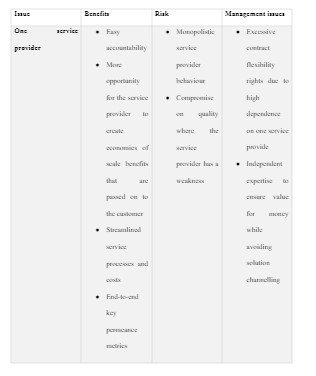
Ploneczka (2017) observed that in many instances where the company follows one supplier, global service providers are used because of their global outreach, economies of scale, and ability to deal with fluctuating demands.
The fourth strategic outsourcing choice that P&G had to go through is choosing a service provider who will have to take on the company’s strategic planning activities. Ideally, any service provider would have to provide a level of services to all the company’s facilities that meet or exceed the current service levels, be a good employer for P&G’s facilities’ employees, be right for the business, ensure a smooth and effective global account management and be a good cultural match for the company.
Upon establishing the evaluation criteria for the service provider, it was looking for, P&G initiated a competitive bidding process during which the company’s management had conducted a background check and inspection of the candidate’s capabilities. Ploneczka (2017) highlighted the important vendor capabilities that clients should consider when searching for a provider, including leadership and business management, contracting and planning, behaviour management, sourcing, domain expertise capabilities, and process improvement capabilities. Appendix 1 illustrates these capabilities and how JLL demonstrated to have each of them.
P&G settled on JLL as its outsourcing partner after almost a year of the bidding process. As earlier mentioned, the contract between the two companies redefined business process outsourcing, whereby they decided to focus on transformation rather than day-to-day management. In short,
P&G took advantage of various external innovation channels and settled on building innovation through strategic procurement, whereby it sought innovative processes or differentiated products from suppliers (Kobyletska, 2018).
Outsourcing majorly presents itself as a spectrum of choices to make. Vitasek & Fenn (2017) preferred a criterion that refers to resource management, resource ownership, supplier/customer relationship, type of contract and typical location of the supplier to differentiate between five types of outsourcing models. In this regard, P&G opined that to successfully incorporate innovation in the process of outsourcing, it must develop a strategic partnership with the suppliers (Zafar & Kantola, 2018). As a result, it chose the enterprise partnership outsourcing model as its preferred outsourcing model.
But signing the contract with JLL did not mean that the hard work was over, considering that in the past few years, several outsourcing contracts have been terminated due to poor governance (Kobyletska, 2018). According to Kobyletska (2018), governance can be defined as the structures and processes that ensures the alignment of strategies and objectives of the involved parties. That said, one of the most significant factors that can strengthen the governing structure is the relationship between the two involved parties. In this regard, Kobyletska (2018) highlighted some of the key elements of a successfully managed outsourcing innovation and as highlighted in appendix 2, the relationship between JLL and P&G exhibits eight out of 10 key elements; including a focus on what should be achieved and not how to achieve; developing and implementing an incentive system for innovation, staying committed to exciting goals, establishing success goals and metrics, setting up project execution within a three-point system framework, provision of compatible and open information, use of technological software to coordinate teams, ensuring that the service provider benefits from the partnership, and sharing any gains that have exceeded the set targets.
3.0 Critical Evaluation of the Factors Influencing the Outsourcing Decision
As time passes, companies change the way they operate their businesses due to certain factors. For example, according to Pulli (2018), competition is becoming stiffer as more market players are entering the market, pushing companies to differentiate and become more competitive. Furthermore, technological evolutions have become more supportive in helping companies to apply new concepts in the manufacturing and delivery of service products to customers. That said, P&G has the required resources, capacities and capabilities to maintain its brand position. Due to competition from other brands such as Unilever, P&G requires to constantly restructure its core and non-core operational activities. But, Kobyletska (2018) argues that this decision can only be guided by a comprehensive evaluation of the company’s competency, responsiveness, and cost-saving capabilities
Having achieved a significant level of success from its operations at their Shared Services Centres, P&G leadership is well-aware of core benefits standardization has on its large-scale production. As it makes such outsourcing arrangements, P&G, through GBS, has established an organisational structure that ensures accountability and ownership of each partner and ensuring that the partner adheres to the standardized management and operational processes within the partnerships. According to Ploneczka (2017) failure to establish such an organizational structure would make it impossible to have oversight across the outsourcing arrangement.
Generally, P&G has applied best practices within its core and non-core business in identifying the best way to manage its strategic alliance with JLL. For example, P&G adopted a joint business planning process that is extensively used within its corporate operations - between different business units and between the company and its clients. The following section highlights some of the best practices P&G has employed in its outsourcing arrangement with
3.1 Effective problem-solving approaches
Pulli (2018) argues that the management of outsourcing partnerships need to be based on clear knowledge of what would be important to both parties. Against this backdrop, the joint business planning adopted by P&G enables both parties (i.e. P&G and JLL) to come together to set targets and develop action plans. In the process, both organizations contribute to the identification of initiatives and projects as well as the success criteria, ensuring that the projects that are important to both parties are included in the plans. Likewise, P&G and JLL work together to identify the challenges and problems that may directly affect the business – challenges which both the organizations would play a significant role in solving. Joint planning is fundamental to the way both JLL and P&G operate and manage their relationship.
3.2 Effective outcome measures
In the outsourcing arrangement between JLL and P&G, just like any other outsourcing arrangement, the measurement centres the performance measurement attributes are highlighted in the service agreements (Zafar & Kantola, 2018). however, to effectively and truly measure the service delivery, there is a need to shift the service measurement from a more granular level to a more aggregate level (Kobyletska, 2018). an examination of the governance process in P&G’s outsourcing arrange ment with JLL since 2010 shows various aggregation techniques and different measures. In response, the company developed a standard SLA technique that clearly defines how more granular level measures were to be created, and how these granular measures should be shifted to more aggregated ones. This ensures that P&G uses a similar measurement and aggregation across all its outsourcing arrangements, ensuring that there is a uniform picture across all the arrangements. Ideally, the SLA measurement process created a standardized means of evaluating how different outsourcing arrangements benefit both parties in an outsourcing arrangement.
Whereas service level measures are useful in evaluating whether the client is receiving the required level of service, they cannot capture all aspects of the outsourcing engagement. In some cases, there are certain elements of service measures of the relationship that cannot be measured effectively using service level measures. In other cases, as Ploneczka (2017) observed, the practitioner might use the wrong service level measurement. In such a scenario, the engagement indicators might show that the service levels are good, yet the client might be unhappy with the fact that whereas everything looks good, they are not satisfied. To address this issue, P&G developed a set of objective measures to complement the already available service measures. The objective measured to facilitate the collection of data at both the management and the operational levels (Zafar & Kantola, 2018).

4.0 Conclusion and Recommendation
In conclusion, P&G can still do more in enhancing its outsourcing processes if it follows other outsourcing models and theories that have proven to be useful. For instance, the GAO’s (2001) outsourcing lifecycle framework can effectively help P&G in identifying the main outsourcing phases that they should undergo, as well as the relevant outsourcing practices associated with each stage. Based on this model, P&G should first develop an outsourcing strategy by identifying whether they should keep a function in-house or contract an external service provider. This distinction can be achieved by grouping the functions into two major categories: based on their potential value creation and based on their potential value capture. Whereas the higher rank of a process indicated that the process is important to the company’s strategy and therefore should not be outsourced, the lower-ranked processes are good candidates for outsourcing. For example, invoice verification is a low-ranking process because it is less crucial in creating customer value. Therefore, this process can be outsourced.
References
ATUT - Academic Team from The University of Tennessee, College of Business Administration 2014 ‘Innovation in Outsourcing: The Case of The Procter & Gamble Company’. Available at: https://www.iaop.org/Firmbuilder/Articles/34/175/3974 (Accessed: 6 April 2021).
Baguzova, L.V., Suslova, J.J., Ananeva, N.V., Kuimov, V.V. and Veremeenko, O.S., 2017. The regional market for the development of outsourcing services. J. Advanced Res. L. & Econ., 8, p.1056.
Bloomberg 2013 Procter & Gamble Names Jones Lang LaSalle “External Business Partner of the Year”. Available at: https://www.bloomberg.com/bb/newsarchive/aja_hVOFfjf8.html (Accessed: 6 April 2021
Choi, J.J., Ju, M., Trigeorgis, L. and Zhang, X.T., 2021. Outsourcing flexibility under financial constraints. Journal of Corporate Finance, 67, p.101890.
Garg, N. and Jain, M., 2019. Outsourcing Project Management Services: Making It Work for IT or Digitally Outsourced Projects. IUP Journal of Business Strategy, 16(4), pp.23-46.
Ike, C.E., 2017. Effect of Outsourcing on Organizational Performance of Selected Quoted Deposit Money Banks in Enugu State, Nigeria (Doctoral dissertation).
Kobyletska, M., 2018. INFORMATION TECHNOLOGY OUTSOURCING. In Сучасні інформаційні технології в суспільстві, науці та освіті.
Mao, H., Gong, Y., Liu, S., Zhang, Y. and Li, K., 2019. Adoption and risk management of bimodal IT outsourcing service: review and directions for future research. International Journal of Internet and Enterprise Management, 9(2), pp.144-159.
Oshri, I., Kotlarsky, J. and Willcocks, L.P. 2009. The Handbook of Global Outsourcing and Offshoring. Houndmills: Palgrave Macmillan.
P&G 2013 ‘Annual Report’. Available at: https://www.pginvestor.com/Cache/1001180053.PDF?Y=&O=PDF&D=&fid=1001180053&T=&iid=4004124 (Accessed: 6 April 2021)
Płoneczka, K., 2017. Outsourcing vs. model usług wspólnych. Ekonomia XXI Wieku, (16), pp.77-86.
Płoneczka, K., 2017. Outsourcing vs. shared services model. Ekonomia XXI Wieku, (4 (16)), pp.77-86.
Pulli, C., 2018. Outsourcing to Vietnamese market in paper industry.
Suresh, Sukruth, and T. Ravichandran. "Value Gains in Business Process Outsourcing: The Vendor Perspective." Information Systems Frontiers (2021): 1-14.
Vitasek, K. and Fenn, I., 2017. Vested outsourcing in corporate real estate and facilities management. Corporate Real Estate Journal, 6(4), pp.323-335.
Vitasek, K. and Flynn, M., 2018. Comparing the why, what and how of performance-based and Vested outsourcing models in CRE. Corporate Real Estate Journal, 8(1), pp.33-52.
Vitasek, K. and Flynn, M., 2019. Making ‘getting what you pay for’a reality in CRE outsourcing deals. Corporate Real Estate Journal, 8(3), pp.277-291.
Vitasek, K., Fenn, I. and Flynn, M., 2018. Choosing the right sourcing model for CRE outsourcing agreements. Corporate Real Estate Journal, 7(3), pp.277-289.
Vitasek, K., Manrodt, K. and Kling, J. 2012 Vested for Success Case study: How P&G and JLL Transformed Corporate Real Estate. Available at: https://www.vestedway.com/wp-content/uploads/2012/09/PG-Case-Study.pdf (Accessed: 6 April 2021)
Zafar, A. and Kantola, J., 2018, December. Relationship between firms' performance and reasons for outsourcing innovation. In ISPIM Innovation Symposium (pp. 1-15). The International Society for Professional Innovation Management (ISPIM).
Appendix 1: Assessment of core JLL’s capabilities
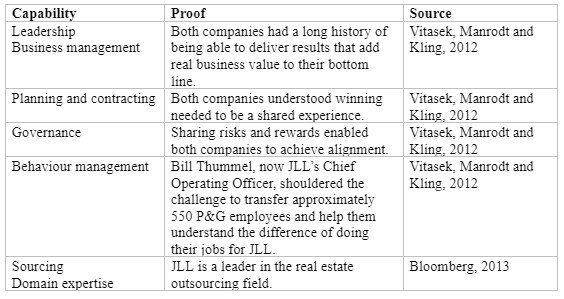

Appendix 2: Assessment of the business relationship between P&G and JLL
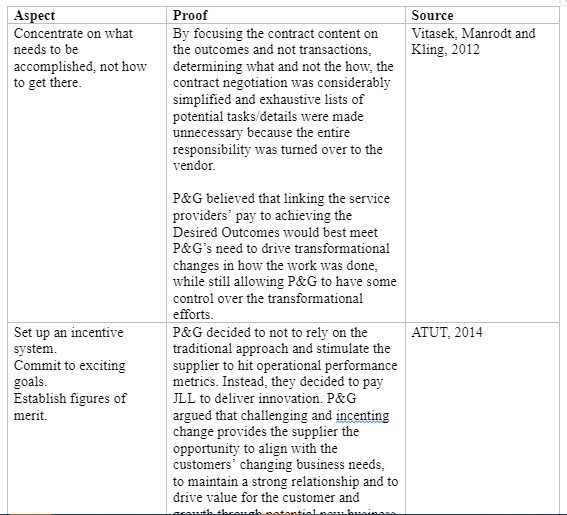
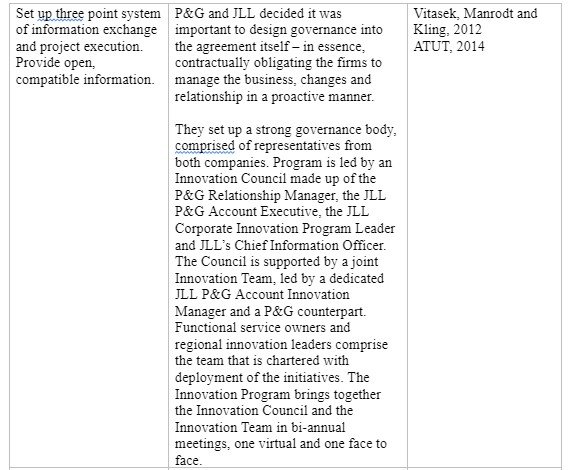

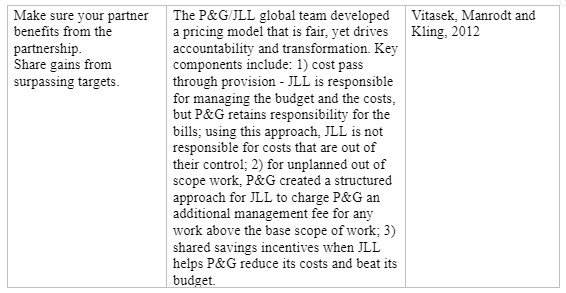
Continue your exploration of Strategic Marketing Blueprint with our related content.
- 24/7 Customer Support
- 100% Customer Satisfaction
- No Privacy Violation
- Quick Services
- Subject Experts



